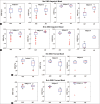Characterization of Event Related Desynchronization in Chronic Stroke Using Motor Imagery Based Brain Computer Interface for Upper Limb Rehabilitation
- PMID: 38835164
- PMCID: PMC11232817
- DOI: 10.4103/aian.aian_1056_23
Characterization of Event Related Desynchronization in Chronic Stroke Using Motor Imagery Based Brain Computer Interface for Upper Limb Rehabilitation
Abstract
Objective: Motor imagery-based brain-computer interface (MI-BCI) is a promising novel mode of stroke rehabilitation. The current study aims to investigate the feasibility of MI-BCI in upper limb rehabilitation of chronic stroke survivors and also to study the early event-related desynchronization after MI-BCI intervention.
Methods: Changes in the characteristics of sensorimotor rhythm modulations in response to a short brain-computer interface (BCI) intervention for upper limb rehabilitation of stroke-disabled hand and normal hand were examined. The participants were trained to modulate their brain rhythms through motor imagery or execution during calibration, and they played a virtual marble game during the feedback session, where the movement of the marble was controlled by their sensorimotor rhythm.
Results: Ipsilesional and contralesional activities were observed in the brain during the upper limb rehabilitation using BCI intervention. All the participants were able to successfully control the position of the virtual marble using their sensorimotor rhythm.
Conclusions: The preliminary results support the feasibility of BCI in upper limb rehabilitation and unveil the capability of MI-BCI as a promising medical intervention. This study provides a strong platform for clinicians to build upon new strategies for stroke rehabilitation by integrating MI-BCI with various therapeutic options to induce neural plasticity and recovery.
Copyright © 2024 Copyright: © 2024 Annals of Indian Academy of Neurology.
Conflict of interest statement
There are no conflicts of interest.
Figures




References
-
- Wolpaw JR, Birbaumer N, McFarland DJ, Pfurtscheller G, Vaughan TM. Brain-computer interfaces for communication and control. Clin Neurophysiol. 2002;113:767–91. - PubMed
-
- Daly JJ, Wolpaw JR. Brain-computer interfaces in neurological rehabilitation. Lancet Neurol. 2008;7:1032–43. - PubMed
-
- Ang KK, Guan C, Chua KSG, Ang BT, Kuah CWK, Wang C, et al. A large clinical study on the ability of stroke patients to use an EEG-based motor imagery brain-computer interface. Clin EEG Neurosci. 2011;42:253–8. - PubMed
-
- Ang KK, Guan C. Brain-computer interface in stroke rehabilitation. J Comput Sci Eng. 2013;7:139–46.

